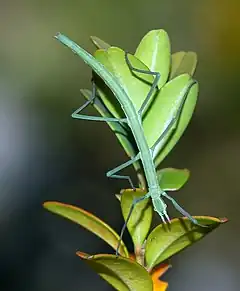| Pijnackeria hispanica | |
|---|---|
 | |
| Scientific classification | |
| Domain: | Eukaryota |
| Kingdom: | Animalia |
| Phylum: | Arthropoda |
| Class: | Insecta |
| Order: | Phasmatodea |
| Family: | Bacillidae |
| Genus: | Pijnackeria |
| Species: | P. hispanica |
| Binomial name | |
| Pijnackeria hispanica (Bolívar, 1878) | |
| Synonyms[1] | |
| |
Pijnackeria hispanica, commonly known as the Spanish walkingstick or the Spanish stick insect, is a species of Phasmid (stick insect) in the family Diapheromeridae.[2] It is found in Spain and France.[1] This species' color can be turquoise, brown, or green. P. hispanica usually feeds on rose leaves. This phasmid is slender with short antennae and yellow or brown eyes with a black horizontal stripe or pseudopupil.
References
- 1 2 "Pijnackeria hispanica". Global Biodiversity Information Facility. Retrieved 26 August 2021.
- ↑ "species Pijnackeria hispanica (Bolívar [Y Urrutia], 1878): Phasmida Species File". phasmida.speciesfile.org. Retrieved 2021-08-26.
This article is issued from Wikipedia. The text is licensed under Creative Commons - Attribution - Sharealike. Additional terms may apply for the media files.